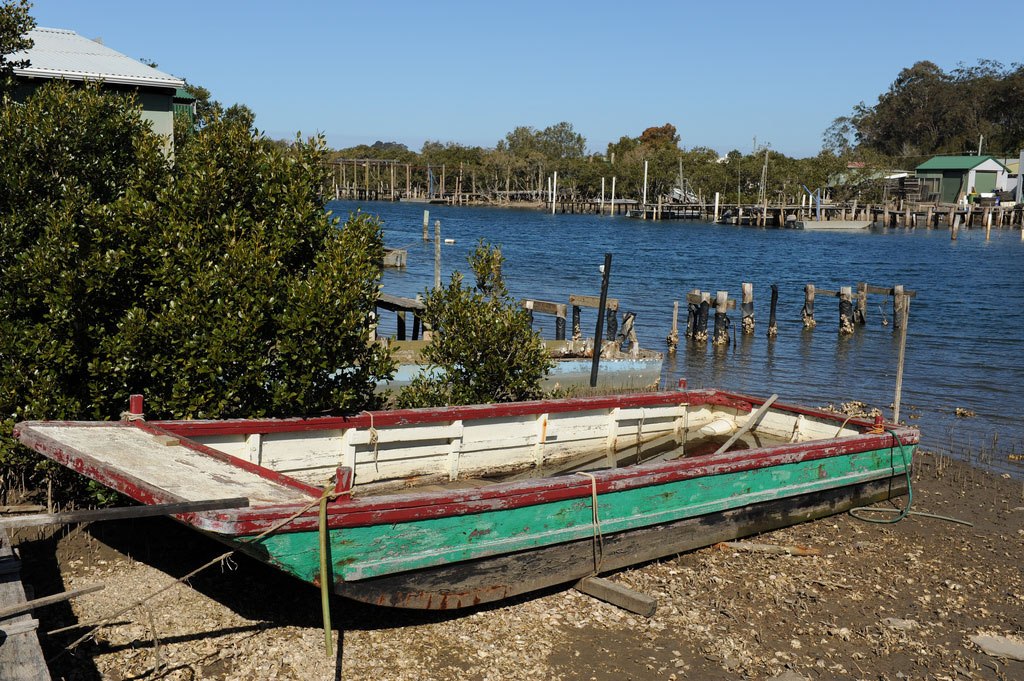

The Clyde River oyster punt, 1970. Australian Register of Historic Vessels, HV000558
Oysters – a first choice on the menu for many people, and while enthusiasts have their favourite coastal spot that they swear has the best specimens, remember that someone has to do the hard work of farming them in shallow water. And for this they need a boat.

The saltwater farms commercially known as oyster leases are located in sheltered waters, and for decades the boat solution has been the punt – so order your oysters now, and while we are waiting for them to be served, let’s dissect some punts.
My recent work for the Maritime Museums of Australia Project Support Scheme (MMAPSS) and an earlier MMAPSS trip in late 2013 have helped me to inspect three punts, and from this have come three plans that record craft from the New South Wales south coast. They are easy-to-copy A3 drawings that encapsulate the boat at 1:20 scale, so it’s a neat little project for the home boatbuilder.
Two are what we might expect from a modern perspective, where we now see aluminium punts working the leases, then trailed home at the end of the day behind a 4WD. These two are wooden scow-shaped craft, but the third is an excellent contrast – still flat bottomed, it’s a sharp-stem skiff shape, with a skiff sort of construction. I first went to Batemans Bay late in 2012 to their Historical Society’s Old Courthouse Museum, then this year I visited a similar Historical Society and Old Courthouse location, but for the Merimbula–Imlay group. On the way from the airport to inspect their punt, we took a detour to see the third boat, a privately owned punt out in a backyard.
Looking at the scows first – they share a pattern of construction as well as their shape. The shape is dead simple: rectangular plan view, rectangular sections with no flare, a profile with a parallel or almost parallel keel and sheer, and a bow that curves up over the last metre or so of its length – this is a traditional scow. The bottom is transverse planked, over three equi-spaced runners and a chine log. A thick transom squares off the back end, bracketed to the bottom and sides by knees; the sides are long planks fore and aft, seam battens on the inside, supported by vertical frames capped with a covering board, and there are plenty of robust section scantlings and belting on the outside.

Clyde River and Batemans Bay Historical Society oyster punt. Drawing by David Payne.
The detail of how all this is done varies, and a closer inspection of the plans shows that just about everything is done in a particular way to slightly different scantlings on one punt compared to the other. There is time to just look at a couple of things for now – knees and runners or stringers.
On the Batemans Bay craft we have a single knee on the centreline and two quarter knees; pretty much standard construction. On the Merimbula scow the transom has a cutaway for an outboard, so it is supported by two knees on the outer two stringers. There are quarter knees, and midships this one is a bit stronger due to the two knees backed by a frame that bracket the sides to the hull.
The runners or stringers on both are full length to the stem. On the Batemans Bay punt they are shallow, with a full-length capping plank that backs up the butt joint where the curved bow section meets the straight bottom section. Further south at Merimbula, they are deeper sections placed on edge, no capping, just an apron piece over the butt joint.

Merimbula oyster punt. Drawing by David Payne.
Merimbula Imlay Historical Society has Gus Cole’s punt with a fabulous family and regional story attached to it, but it’s a different shape and construction. The knees are the big talking point: lots of grown knees in all the usual spots they are required, and then a couple more on the flat on the bottom – lodging knees normally seen at deck level, and a neat form of bracketing against any possible twisting. It’s a rigid little craft, and maybe quite old too, built somewhere between 1918 and 1930.

Gus Cole’s oyster punt. Photo: David Payne.
Elegant and functional, this was Gus’s boat and the drawings show how it looked after he built it, plus an ongoing repair or two. The plan now shows the outcome of an idea that was mostly, or perhaps all, just in his head as he built it – he might not have done any sketch at all.
Drawing a plan before building is an organised way of creating the item. With a drawing of the end result we can work backwards, speculating on why it was done this way. Maybe some of it is self-evident – the bottom, side and transom need joints and stiffening support, joints give longitudinal strength at edges, there is backing at the seams to stop it leaking – but the lodging knees in the bottom are intriguing, and might even have been added later.

Merimbula Imlay Historical Society oyster punt. Drawing by David Payne.
Now, none of this affects the flavour in your oysters that are arriving as we finish this story, but it’s way past time to give some attention to those faithful punts that allow the oysters to make their way on to your plate in the first place.
So, with three punts and three plans, the market is cornered for the time being. Someone can start again and build one of these, or use them as a springboard to do something in 25-millimetre hoop pine marine ply and epoxy resin. Get in touch if you need a drawing – and meanwhile, enjoy!
